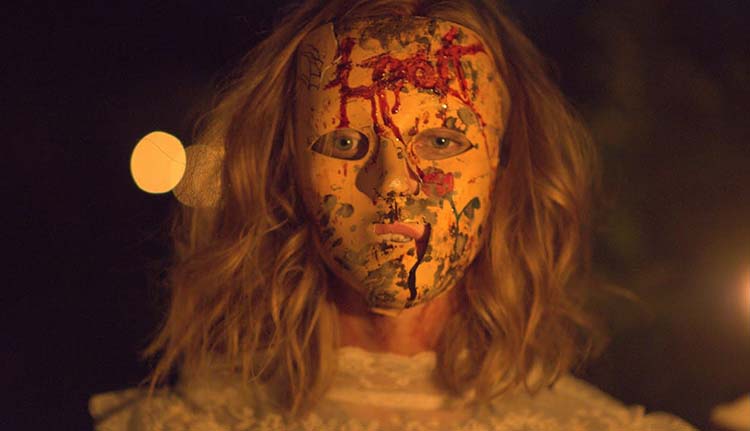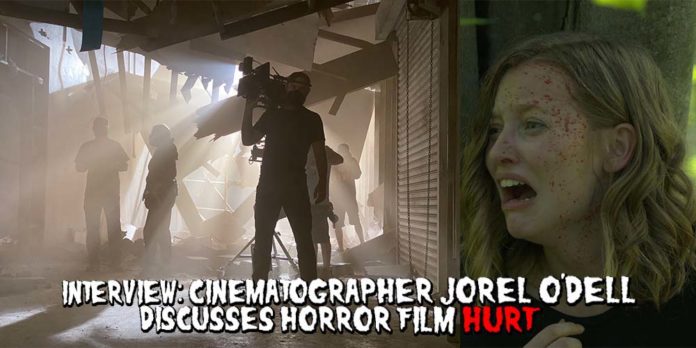A former soldier encounters a horrific hayride in the horror film HURT from director Sonny Mallhi (Family Blood) and starring Emily Van Raay, where cinematographer Jorel O’Dell draws out the tension and fear.
Emily Van Raay (Thank You for Your Patience) is Rose, a woman living paycheck-to-paycheck while her soldier husband Tommy, played by Andrew Creer (You), is away on deployment. Rose goes about her business, first watching a horror movie, then working at a convenience store when Tommy makes a surprise appearance. He’s back from the war and ready to settle down. However, Tommy’s living with PTSD and the sights and sounds of the world around him sometimes compound and challenge his mental state. Things get violently worse for Tommy and Rose when a hayride on Halloween transforms the couple forever.
PopAxiom spoke with Jorel about his cosmic name, taking his camera everywhere, and the process of making Hurt.
Is Jorel named after Superman’s father?
I was named after Marlon Brando from Superman. My whole life, no one said anything about it. But then Russell Crowe played him, and suddenly I couldn’t make a reservation at a restaurant without people commenting. I was well into my 30s at that point. Thanks, Russell.
Jorel’s been a musician and actor on stage and screen. Why did he become a cinematographer?
I understood nothing but the director. It was a very auteur-driven industry. Even in film school, we’d study the great directors. I don’t think the curriculums were as advanced then as they are now. I didn’t understand cinematography even though I’d been shooting stills my whole life. I’d been processing and developing my photos since I was six. My dad taught me exposure by drawing out the triangle. I was viewing the world through lenses. But I also played music and was an actor performing worldwide in theatre productions. The whole time I took my camera everywhere, it was the one constant.

Hurt’s production wrapped in 2018, and the original cut premiered to mixed results. What was that experience like?
The cut at Fantasia Film Festival was basically unwatchable. It got torn up by critics, and none of us were very excited when we left the theater. So it’s not the same film that you see today. But it’s the classic story; it happened to Star Wars. First, the film was too long; it didn’t make sense, then Marcia Lucas edited it into the Star Wars that we have today that changed the world. But Sonny brought it home in the new cut. I’m so proud of what he accomplished. It’s a slow-burn kind of horror with an ending that punches viewers in the gut and stays with you.
Early on, Rose and Tommy share a character-driven scene outside at a picnic table at sunset. So what are the challenges of shooting outdoors?
In that sequence, we have the front of the house, the back of the house, and the inside. Those were three different geographical locations shot over four weeks. Each area had a different orientation to the sun too. So, we had to make continuity choices in our scheduling days. That backyard section goes from late afternoon into the sunset into the evening. So, we planned for a day where we’d shoot that at sunset, and I rode the exposure. There’s a shot of Tommy alone drinking a beer in the film. That’s all-natural light. As it gets darker, I influenced it with light by using two M18s bounced into an Ultrabounce. That’s all the light that I had.
As a micro-budget film, Hurt shot over a short period. How does that affect the process?
It was fast, furious, and limited. We had incredible limits that forced us to make quick decisions. I wasn’t just changing from a wide lens to a long lens but from a wide anamorphic lens to one of two long spherical lenses. I’ve got to protect those images so that I don’t take the audience out of the anamorphic experience when switching to a spherical lens. So we’re constantly navigating limited tools, limited time, and limited hands.
What references entered the early conversations while making Hurt?
Texas Chainsaw was a big part of the conversation for two reasons. One because of the film’s opening, which I won’t give away. And two, Sonny’s making a commentary on slasher films and showing an understanding of the genre. It was such a new take on slasher films invested in its characters. There are also similarities in the sort of world Texas Chainsaw and Hurt were made. Both are gritty, low-budget, run-and-gun kinds of films.
Is Hurt on your watch list?
Thanks to Jorel O’Dell and Projection PR
for making this interview possible.
Find more interviews from Ruben R. Diaz here!


